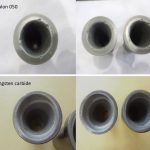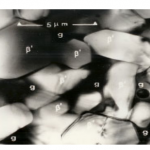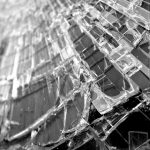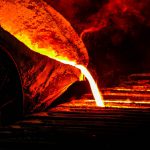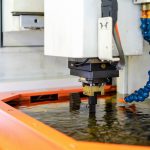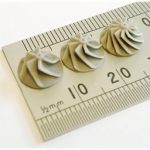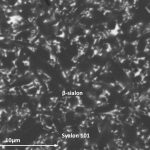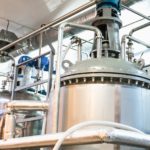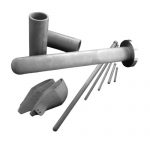A car engine block can weigh anything from 90 kilograms (kg) to over half a tonne without its associated parts, such as the power train or other directly connected components. The weight of the vehicle is one of the defining factors in its overall performance and efficiency, and reducing the weight profiles of integral components has been an ongoing challenge for advanced engineering of modern vehicles.
Continue readingInsight into the Hardness of Silicon Nitride
At International Syalons, we have explored the mechanical properties of silicon nitride (Si3N4) at great length. Silicon nitride is an advanced engineering ceramic that circumvents many of the conventional drawbacks of numerous oxide ceramics. Outstanding fracture toughness and high moduli of both rupture and elasticity impart excellent resistance to multiple wearing phenomena. This enables silicon nitride-based ceramics to withstand severe operating conditions that may cause comparatively brittle ceramics to propagate flaws, deform, or fail.Continue reading
The Fracture Toughness of Ceramic Materials
High strength ceramic materials are pervasively utilized in demanding industrial applications, owing to their unique thermomechanical characteristics. Typically, advanced ceramics exhibit tightly-bound granular structures with extremely dense microstructural arrangements. This imparts varying levels of material strength and resistance to chemical attack, depending on the distinct chemical makeup of the ceramic.
Continue readingHigh strength ceramic materials are pervasively utilized in demanding industrial applications, owing to their unique thermomechanical characteristics. Typically, advanced ceramics exhibit tightly-bound granular structures with extremely dense microstructural arrangements. This imparts varying levels of material strength and resistance to chemical attack, depending on the distinct chemical makeup of the ceramic.
Continue readingExploring the Ultra-High Temperature Strength of Sialon Technical Ceramics
Updated: Originally published on 25/10/2018
Silicon nitride (Si3N4) ceramics have outstanding thermal shock resistance and ultra-high temperature strength values, exceeding many technical ceramics in terms of their resistance to thermodynamic stress. The main challenge associated with manufacturing silicon nitride for industrial applications is of cost-effectively achieving full densification of green bodies. Hot pressing methods yield fully dense, high-performance technical ceramics but at excessive costs.
Continue readingThe Electrical Properties of Si3N4
Silicon nitride (Si3N4) is one of the most advanced engineering ceramics on the market, providing an outstanding blend of mechanical and thermal properties. Each individual member of the Si3N4 ceramic family is comprised of silicon (Si) and nitrogen (N) in a densely-packed atomic arrangement of high-strength intra-structural covalent bonds. This provides the basis for the material’s high thermal and mechanical performance, as well as interesting electrical properties which can be tailored to specific applications.
Continue readingSilicon nitride (Si3N4) is one of the most advanced engineering ceramics on the market, providing an outstanding blend of mechanical and thermal properties. Each individual member of the Si3N4 ceramic family is comprised of silicon (Si) and nitrogen (N) in a densely-packed atomic arrangement of high-strength intra-structural covalent bonds. This provides the basis for the material’s high thermal and mechanical performance, as well as interesting electrical properties which can be tailored to specific applications.
Continue readingCeramic 3D Printing: Latest Developments
Updated 11/11/21 to include the most accurate and up-to-date information.
Technical ceramics are ubiquitous in industrial manufacturing with a storied history of innovation and versatility. Manufacturers of some of the most hard-wearing and high-strength engineered ceramics worldwide are committed to pushing the envelope with regards to the capability of these novel materials. This has included fine-tuning the chemical composition of ceramic additives and raw materials to reduce the manufacturing costs of high-performance ceramics such as silicon nitride. All this, whilst still improving the material’s physical and thermal properties.
Continue readingComparing Syalon 101 to Other Types of Ceramic Materials
Syalon 101 is a Si-Al-O-N ceramic material with a similar crystallographic structure to beta-phase silicon nitride (β-Si3N4) which is also engineered for its extraordinary strength, toughness, and hardness characteristics. First envisaged as a cost-effective alternative to conventional silicon nitride, Syalon 101 can now compete with a broad range of established engineering ceramic materials.
Continue readingThermal Properties of Silicon Nitride: Thermal Conductivity
Silicon nitride ceramics are a unique family of materials engineered for optimal efficiency in extremely demanding thermodynamic conditions. Several derivatives of the original beta-phase silicon nitride Syalon 101 have been designed for enhanced corrosion resistance or improved formability, but these outstanding mechanical and thermal properties still underline the performance of the overarching product line.
Continue readingKey Si3N4 Applications in the Chemical and Process Industry
The chemical and process industry is concerned with converting raw materials into semi-finished or finished products via thermochemical reactions. This covers an extensive range of industrial and commercial processes, including petroleum metering and petrochemical production of organic and inorganic polymers. Chemical and process industries are typified by chemical reactions of highly corrosive or erosive media at ambient or elevated temperatures.
Continue readingWhat is Slip Casting?
Mankind has been using moulds to manufacture ceramics for centuries. The precise origin of slip casting is still debated, with variations of the method observed in prehistoric Peruvian cultures and the ancient empires of the Mediterranean Sea. The French rather romantically coined the phrase coulage to describe the process of slip casting, which roughly translates as casting through shrinkage. This term is also associated with mass production, which is why the discovery of the technique is often dated centuries after indigenous peoples in Peru first used slip casting to construct simple panpipes.
Continue reading
